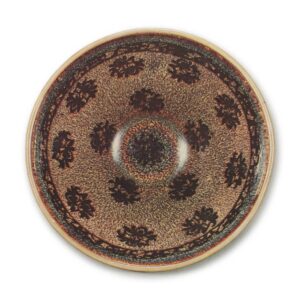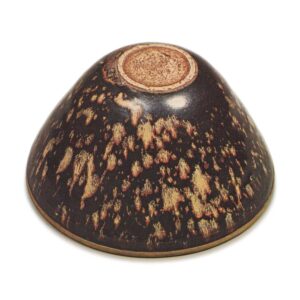

Daimeibutsu
National Treasure
Height: 6.4cm
Diameter: 11.7cm
Outer diameter of foot ring: 3.5cm
Height of foot ring: 0.1cm
Many of the surviving pieces of Taipa ware have been handed down in Japan, and there are many that are of excellent workmanship, but this is a famous bowl that has been famous since early times as the most elegant and refined of the many Taipa ware pieces.
The shape of the bowl is the usual bowl shape for a tea bowl, and there is no twist at the top like a kenkan. The waist is rounded, and at first glance it looks like a so-called go-sutsu-doko shape, but it has a very low foot ring. Furthermore, the way the foot ring is cut is not at all rough. The tatami mat has a uniform width and is finished to a perfect circle. The lid is a rare example of a very carefully made mokoshi-gai lid. The body is a slightly yellowish gray, characteristic of mokoshi-gai, and is finely textured and tightly fired.
The exterior is covered with a black glaze and sprinkled with straw ash glaze to create a so-called tortoiseshell pattern, while the interior is covered with a black glaze and cut paper stencils, which are then carefully sprinkled with straw ash glaze before being removed to reveal the pattern in black. The main pattern is is a kind of small flower pattern, with two peony flowers placed back to back in an irregular shape, with one in the center, five around it, and nine more on the outside, all arranged in a regular pattern at regular intervals. In addition, a thin band of floral arabesque pattern is expressed in the same way with a black stencil around the entire piece. . A narrow band of floral scrollwork is also expressed using the same black stencil.
This elaborate and intricate design is unusual for a tea caddy, and it has a distinctive style and is an excellent design.
The mottled pattern of the straw ash glaze on the black glaze on the inside is extremely fine, with a marbled effect of purple-brown and light yellow-white, and the inside of the bowl and the area under the rim are tinged with blue and red, creating a glittering, gorgeous effect. The overall appearance is pleasant, with the moist sheen characteristic of tea bowls that have been handed down through the generations.
The rim is decorated with a makuro-style border.
It was made at the Jizhou kiln in Jiangxi province. It was probably made during the Southern Song dynasty (12th – 13th century). It is thought that it was brought to Japan early on and has been handed down through the generations, but the identity of its early owner is unknown.
In the middle of the Edo period, it was owned by Ueda Saburoemon, a wealthy merchant from Osaka, but in 1778, it was acquired by Matsudaira Fumai for 150 ryou through the mediation of Kawachiya Sohai, a dealer in Edo.
Lord Fumai, along with the Katsujiro Kuro, Kizaemon Ido, Yuteki Tenmoku, and Kaga Ido, considered this to be a great national treasure and especially prized it. Since then, it has been passed down in the Matsudaira family of Unshu, and in 1929, after being transferred to the current owner after the war, it was designated as a new national treasure. It is an outstanding relic of the Tenmoku tea bowl.



